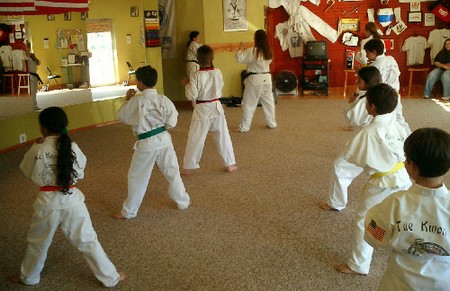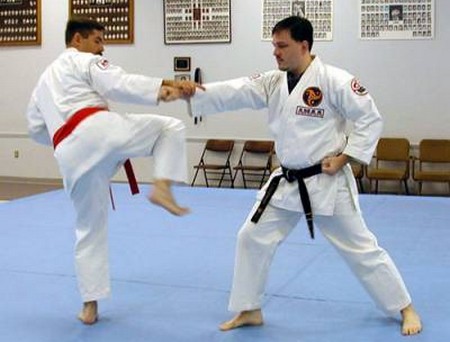To see a picture of samurai warriors in full battle dress is to wonder how they ever got on their horses, or kept from laughing themselves silly just looking at the comical helmets perched atop their heads. Except for the part of the face below the eyes, every body part was more or less covered by layers of woven cloth or metal. Helmets resembled everything from an upside-down Bunt-cake pan to a dunce cap with a chin strap. Their weapon of choice was a sword or bow and arrow, both of which appear difficult to hold.
Then there were the peasants, who couldn’t afford such elaborate protective equipment. But rather than give up the fight, so to speak, they adapted a less pretentious strategy. Instead of arrows, they carried farm tools. Instead of armor, they stuck with their basic work attire—a shirt and slacks. Though unassuming, these “bare-handed” fighters were forces to be reckoned with.
As a sport, martial arts fighting is limited to the training floor. You don’t have to worry about fellow students lurking in the parking lot waiting to attack you, or preparing to shoot an arrow through your heart. Nevertheless, even on the floor, you can get hurt. And while it’s possible to take a misdirected or miscalculated punch in the stomach during basic training drills, students are more likely to incur a punch or kick during sparring exercises, which is why most martial arts styles require students to wear protective equipment only when they spar. (Unless, of course, you’re studying the swordsmanship skills found in kendo, in which case you’ll wear headgear and breastplates during most of your training.)
When I first started training, much of the protective equipment that’s mandatory today was optional then. If I didn’t want to wear a helmet, I didn’t have to. But sky-high insurance premiums pretty much put an end to that. Today, instructors require their students to wear more equipment. When I started studying the martial arts, students sparred wearing gloves and footpads, also known as boots. Now gearing up for sparring requires not only gloves and footpads, but headgear and a mouth guard. Optional are such protective items as forearm and elbow pads, knee, shin and instep pads, rib pads, and chest or breast protectors. There’s even a female version of men’s athletic supporter and cup, which to my knowledge is optional at most schools. However, it may not be long before more optional items become mandatory.
If all this sounds like a lot of equipment, that’s because it is. Fortunately, thoughtful design and lightweight materials make, for the most part, for equipment that’s comfortable. As your training progresses, you’ll decide what equipment feels right for you. For example, the only time I wore a rib protector was the period prior to and during my black belt test when the amount and forcefulness of sparring was at an all-time high. Then I needed the protection, but quite frankly it felt as though I was wearing what I can only imagine it must feel like to wear a corset. To alleviate the constrictive feeling brought on by the rib protector, I took a pair of scissors to it, cutting off the bottom half, which exposed my stomach but still protected my ribs. I figured I’d rather have the wind knocked out of me from a gut punch, than a broken or cracked rib.
As a new student, you won’t be required to buy all the equipment you’ll ever need. Initially, you’ll only have to carry your uniform to class, since most students prefer to change at the school and some schools don’t allow students to wear their uniforms in public except in cases when students perform in tournaments. But as you continue to train, you’ll build your equipment collection and find yourself toting a lot of items back and forth to class. And since in most cases you won’t know ahead of time whether you’ll need your protective equipment, it’s a good idea to always have it with you. That’s why it pays to invest in a large enough bag to accommodate all the belongings you’ll eventually need. Choose one with pockets to hold small items such as your mouth guard, spare tampons, a hair tie, and Band-Aids.
While few would argue that some amount of equipment is essential, some claim that too much equipment makes students poor sparrers. The thinking goes that if I’m protected head to toe with equipment, I don’t care if I get hit. Theoretically, my defensive moves—blocks, for example— will suffer as I concentrate only on offensive moves such as kicks and punches.
In addition, equipment often gives students a false sense of security. When you see disclaimers such as “User assumes risk of injury” printed across a rib protector, it means it’s possible you could incur an injury to the very area the equipment is designed to protect—and if you do, you can’t force the manufacturer to pay your medical bills. The same goes for other types of equipment. Just because you’re wearing gloves and foot pads doesn’t mean you can’t break or jam a finger or toe. Simply put, all the equipment in the world won’t protect you 100 percent; it’ll only decrease the risk of injury.
Nevertheless, just as you have a degree of choice when it comes to choosing a uniform, you also have some choice when it comes to deciding on protective equipment. Use this freedom of choice, and you’ll find yourself enjoying your training a whole lot more.

